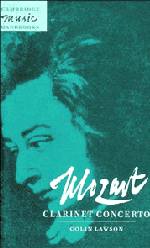Book contents
- Frontmatter
- Contents
- List of illustrations
- Preface
- 1 The eighteenth-century clarinet and its music
- 2 Mozart, Stadler and the clarinet
- 3 The genesis and reception of the Concerto
- 4 Stadler's clarinet and its revival
- 5 Mozart's original text
- 6 Design and structure
- 7 Performance practice
- Appendix 1 A review of the Breitkopf and Härtel edition in the Leipzig Allgemeine Musikalische Zeitung, 4 (March 1802)
- Appendix 2 Surviving instruments
- Appendix 3 A list of works composed by Mozart's clarinettist, Anton Stadler
- Notes
- Select bibliography
- Index
5 - Mozart's original text
Published online by Cambridge University Press: 05 June 2012
- Frontmatter
- Contents
- List of illustrations
- Preface
- 1 The eighteenth-century clarinet and its music
- 2 Mozart, Stadler and the clarinet
- 3 The genesis and reception of the Concerto
- 4 Stadler's clarinet and its revival
- 5 Mozart's original text
- 6 Design and structure
- 7 Performance practice
- Appendix 1 A review of the Breitkopf and Härtel edition in the Leipzig Allgemeine Musikalische Zeitung, 4 (March 1802)
- Appendix 2 Surviving instruments
- Appendix 3 A list of works composed by Mozart's clarinettist, Anton Stadler
- Notes
- Select bibliography
- Index
Summary
The reconstruction
A reconstruction of Mozart's original text for basset clarinet was published in 1977 as part of the Neue Mozart-Ausgabe, since when performances on the extended instrument have gradually been winning widespread acceptance, both in the concert hall and in recordings. Because the NMA text is widely available for consultation, not every detail of the reconstruction process will be explored within this chapter. The two primary sources have already been identified, comprising (1) Mozart's own initial 199 bars from the autograph sketch K621b for basset horn in G, and (2) musical examples given in the 1802 Allgemeine Musikalische Zeitung review of the first Breitkopf and Härtel edition. These can be supplemented by internal evidence of orchestration and melodic shape.
With remarkable percipience, although without apparent knowledge of K621b or the AMZ review, George Dazeley in 1948 incorporated a list of emendations to the traditional text for normal clarinet, which contained the essential material for a complete reconstruction. The first modern performance of a basset clarinet version of the Concerto was given in Prague in 1951 by Milan Kostorhryz's pupil Josef Janous. Jirí Kratochvíl played the Quintet on a specially reconstructed instrument in 1956 and subsequently published a series of articles on Mozart's original texts for both pieces. The year 1967 witnessed the publication of the seminal article by Ernst Hess, which drew attention to the AMZ review and addressed various problems in re-creating the text.
- Type
- Chapter
- Information
- Mozart: Clarinet Concerto , pp. 52 - 59Publisher: Cambridge University PressPrint publication year: 1996

